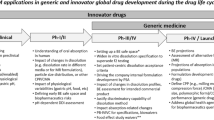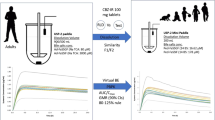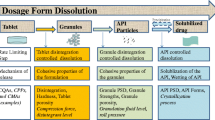Abstract
Bioequivalence (BE) studies support the approval and clinical use of both new drug and generic drug products. Virtual BE studies have been conducted using physiologically based pharmacokinetic absorption models (PBPK AMs) to aid the evaluations of generic drug products. The aim of the current study is to determine the dissolution boundary for maintaining BE between the test and reference oseltamivir phosphate (OP) drug products using the PBPK AM–based virtual BE studies in adults and pediatrics. The adult PBPK AM for OP and its metabolite oseltamivir carboxylate (OC) are developed and verified/validated using intravenous and oral data from multiple generic OP products. The pediatric PBPK AM is extrapolated from the adult PBPK AM. The virtual BE analysis is conducted using simulated PK profiles from the reference products and the generic products with theoretical dissolution profiles as inputs. Results indicate that the generic products with 10% slower dissolution profile than the pivotal reference bio-batch could still maintain BE to the reference in adults. In contrast, a stringent trend of dissolution boundary is observed for pediatrics (6% slower for adolescents, 4% slower for 0–2-month neonates) to maintain BE. This study addresses the important applications of PBPK AM in evaluating BE in different age populations, mitigating risk of formulation/batch changes, and providing a quantitative basis for setting clinically relevant dissolution specifications for OP and OC in both adults and pediatrics.




Similar content being viewed by others
References
Liew KB, Peh KK, Loh GO, Tan YT. Three-ways crossover bioequivalence study of cephalexin in healthy Malay volunteers. Drug Dev Ind Pharm. 2014;40(9):1156–62.
U.S. Food and Drug Administration. Guidance for industry: bioequivalence studies with pharmacokinetic endpoints for drugs submitted under an abbreviated new drug application. 2013.
Baek IH, Lee BY, Kang W, Kwon KI. Comparison of average, scaled average, and population bioequivalence methods for assessment of highly variable drugs: an experience with doxifluridine in beagle dogs. Eur J Pharm Sci. 2010;39(1–3):175–80.
U.S. Food and Drug Administration. Guidance for industry: waiver of in vivo bioavailability and bioequivalence studies for immediate-release solid oral dosage forms based on a Biopharmaceutics Classification System. 2017.
U.S. Food and Drug Administration. Product-specific guidance for mesalamine extended release capsule. Recommended September 2012, Revised July 2014, 2017.
Heimbach T, Suarez-Sharp S, Kakhi M, Holmstock N, Olivares-Morales A, Pepin X, et al. Dissolution and translational modeling strategies toward establishing an in vitro-in vivo link-a workshop summary report. AAPS J. 2019;21(2):29.
Zhang X, Lionberger RA, Davit BM, Yu LX. Utility of physiologically based absorption modeling in implementing quality by design in drug development. AAPS J. 2011;13(1):59–71.
Vaidhyanathan S, Wang X, Crison J, Varia S, Gao JZH, Saxena A, et al. Bioequivalence comparison of pediatric dasatinib formulations and elucidation of absorption mechanisms through integrated PBPK modeling. J Pharm Sci. 2019;108(1):741–9.
Lionberger RA, Raw AS, Kim SH, Zhang X, Yu LX. Use of partial AUC to demonstrate bioequivalence of zolpidem tartrate extended release formulations. Pharm Res. 2012;29(4):1110–20.
Zaid AN, Shraim N, Radwan A, Jaradat N, Hirzallah S, Issa I, et al. Does GastroPlus support similarity and dissimilarity factors of in vitro-in vivo prediction in biowaiver studies? A lower strength amlodipine as a model drug. Drug Res (Stuttg). 2018;68(11):625–30.
Babiskin AH, Zhang X. Application of physiologically based absorption modeling for amphetamine salts drug products in generic drug evaluation. J Pharm Sci. 2015;104(9):3170–82.
Intra-Agency Agreement Between the Eunice Kennedy Shriver National Institute of Child Health and Human Development (NICHD) and the U.S. Food and Drug Administration (FDA) Oral formulations platform—Report 1. Available at: https://www.nichd.nih.gov/sites/default/files/inline-files/Formulations_Platform_Report1.pdf
Davies BE. Pharmacokinetics of oseltamivir: an oral antiviral for the treatment and prophylaxis of influenza in diverse populations. J Antimicrob Chemother. 2010;65(Suppl 2):ii5–ii10.
Parrott N, Davies B, Hoffmann G, Koerner A, Lave T, Prinssen E, et al. Development of a physiologically based model for oseltamivir and simulation of pharmacokinetics in neonates and infants. Clin Pharmacokinet. 2011;50(9):613–23.
Gao G, Law F, Wong RNS, Mak NK, Sze M, Yang M. A physiologically-based pharmacokinetic model of oseltamivir phosphate and its carboxylate metabolite for rats and humans. ADMET DMPK. 2019;7(1):22–43.
Shi D, Yang J, Yang D, LeCluyse EL, Black C, You L, et al. Anti-influenza prodrug oseltamivir is activated by carboxylesterase human carboxylesterase 1, and the activation is inhibited by antiplatelet agent clopidogrel. J Pharmacol Exp Ther. 2006;319(3):1477–84.
Zhu HJ, Markowitz JS. Activation of the antiviral prodrug oseltamivir is impaired by two newly identified carboxylesterase 1 variants. Drug Metab Dispos. 2009;37(2):264–7.
Hu ZY, Edginton AN, Laizure SC, Parker RB. Physiologically based pharmacokinetic modeling of impaired carboxylesterase-1 activity: effects on oseltamivir disposition. Clin Pharmacokinet. 2014;53(9):825–36.
Hines RN, Simpson PM, McCarver DG. Age-dependent human hepatic carboxylesterase 1 (CES1) and carboxylesterase 2 (CES2) postnatal ontogeny. Drug Metab Dispos. 2016;44(7):959–66.
Boberg M, Vrana M, Mehrotra A, Pearce RE, Gaedigk A, Bhatt DK, et al. Age-dependent absolute abundance of hepatic carboxylesterases (CES1 and CES2) by LC-MS/MS proteomics: application to PBPK modeling of oseltamivir in vivo pharmacokinetics in infants. Drug Metab Dispos. 2017;45(2):216–23.
Poulin P, Theil FP. Prediction of pharmacokinetics prior to in vivo studies. 1. Mechanism-based prediction of volume of distribution. J Pharm Sci. 2002;91(1):129–56.
Agoram B, Woltosz WS, Bolger MB. Predicting the impact of physiological and biochemical processes on oral drug bioavailability. Adv Drug Deliv Rev. 2001;50(Suppl 1):S41–67.
Huang W, Lee SL, Yu LX. Mechanistic approaches to predicting oral drug absorption. AAPS J. 2009;11(2):217–24.
Kimberlin DW, Acosta EP, Prichard MN, Sanchez PJ, Ampofo K, Lang D, et al. Oseltamivir pharmacokinetics, dosing, and resistance among children aged <2 years with influenza. J Infect Dis. 2013;207(5):709–20.
U.S. Food and Drug Administration. Dissolution method database for oseltamivir phosphate capsules. Available at: https://www.accessdata.fda.gov/scripts/CDER/dissolution/index.cfm.
He G, Massarella J, Ward P. Clinical pharmacokinetics of the prodrug oseltamivir and its active metabolite Ro 64-0802. Clin Pharmacokinet. 1999;37(6):471–84.
U.S. Food and Drug Administration. Guidance for industry: statistical approaches to establishing bioequivalence. 2001.
Flanagan T, Van Peer A, Lindahl A. Use of physiologically relevant biopharmaceutics tools within the pharmaceutical industry and in regulatory sciences: where are we now and what are the gaps? Eur J Pharm Sci. 2016;91:84–90.
Hsu V, de L T Vieira M, Zhao P, Zhang L, Zheng JH, Nordmark A, et al. Towards quantitation of the effects of renal impairment and probenecid inhibition on kidney uptake and efflux transporters, using physiologically based pharmacokinetic modelling and simulations. Clin Pharmacokinet. 2014;53(3):283–93.
Ose A, Ito M, Kusuhara H, Yamatsugu K, Kanai M, Shibasaki M, et al. Limited brain distribution of [3R,4R,5S]-4-acetamido-5-amino-3-(1-ethylpropoxy)-1-cyclohexene-1-carboxylate phosphate (Ro 64-0802), a pharmacologically active form of oseltamivir, by active efflux across the blood-brain barrier mediated by organic anion transporter 3 (Oat3/Slc22a8) and multidrug resistance-associated protein 4 (Mrp4/Abcc4). Drug Metab Dispos. 2009;37(2):315–21.
Johnson TN. The problems in scaling adult drug doses to children. Arch Dis Child. 2008;93(3):207–11.
Manolis E, Pons G. Proposals for model-based paediatric medicinal development within the current European Union regulatory framework. Br J Clin Pharmacol. 2009;68(4):493–501.
Hoppu K. Can we get the necessary clinical trials in children and avoid the unnecessary ones? Eur J Clin Pharmacol. 2009;65(8):747–8.
Acosta EP, Jester P, Gal P, Wimmer J, Wade J, Whitley RJ, et al. Oseltamivir dosing for influenza infection in premature neonates. J Infect Dis. 2010;202(4):563–6.
Standing JF, Nika A, Tsagris V, Kapetanakis I, Maltezou HC, Kafetzis DA, et al. Oseltamivir pharmacokinetics and clinical experience in neonates and infants during an outbreak of H1N1 influenza A virus infection in a neonatal intensive care unit. Antimicrob Agents Chemother. 2012;56(7):3833–40.
Dixit R, Matthews S, Khandaker G, Walker K, Festa M, Booy R. Pharmacokinetics of oseltamivir in infants under the age of 1 year. Clin Transl Med. 2016;5(1):37.
Oo C, Hill G, Dorr A, Liu B, Boellner S, Ward P. Pharmacokinetics of anti-influenza prodrug oseltamivir in children aged 1-5 years. Eur J Clin Pharmacol. 2003;59(5–6):411–5.
Oo C, Barrett J, Hill G, Mann J, Dorr A, Dutkowski R, et al. Pharmacokinetics and dosage recommendations for an oseltamivir oral suspension for the treatment of influenza in children. Paediatr Drugs. 2001;3(3):229–36.
Kamal MA, Van Wart SA, Rayner CR, Subramoney V, Reynolds DK, Bulik CC, et al. Population pharmacokinetics of oseltamivir: pediatrics through geriatrics. Antimicrob Agents Chemother. 2013;57(8):3470–7.
Acknowledgments
This project is supported by US Food and Drug Administration MCMi funded Oak Ridge Institute for Science and Education (ORISE) Fellowships. Drs. Lei Miao and Youssef Mousa were supported by an appointment to the Research Participation Program at CDER, administered by ORISE through an interagency agreement between the US Department of Energy and the FDA.
Author information
Authors and Affiliations
Corresponding author
Ethics declarations
Disclaimer
The views expressed in this article are those of the authors and should not be construed to represent the FDA’s views or policies. The mention of commercial products, their sources, or their use in connection with material reported herein is not to be construed as either an actual or implied endorsement of such products by the FDA.
Additional information
Publisher’s Note
Springer Nature remains neutral with regard to jurisdictional claims in published maps and institutional affiliations.
Rights and permissions
About this article
Cite this article
Miao, L., Mousa, Y.M., Zhao, L. et al. Using a Physiologically Based Pharmacokinetic Absorption Model to Establish Dissolution Bioequivalence Safe Space for Oseltamivir in Adult and Pediatric Populations. AAPS J 22, 107 (2020). https://doi.org/10.1208/s12248-020-00493-6
Received:
Accepted:
Published:
DOI: https://doi.org/10.1208/s12248-020-00493-6




